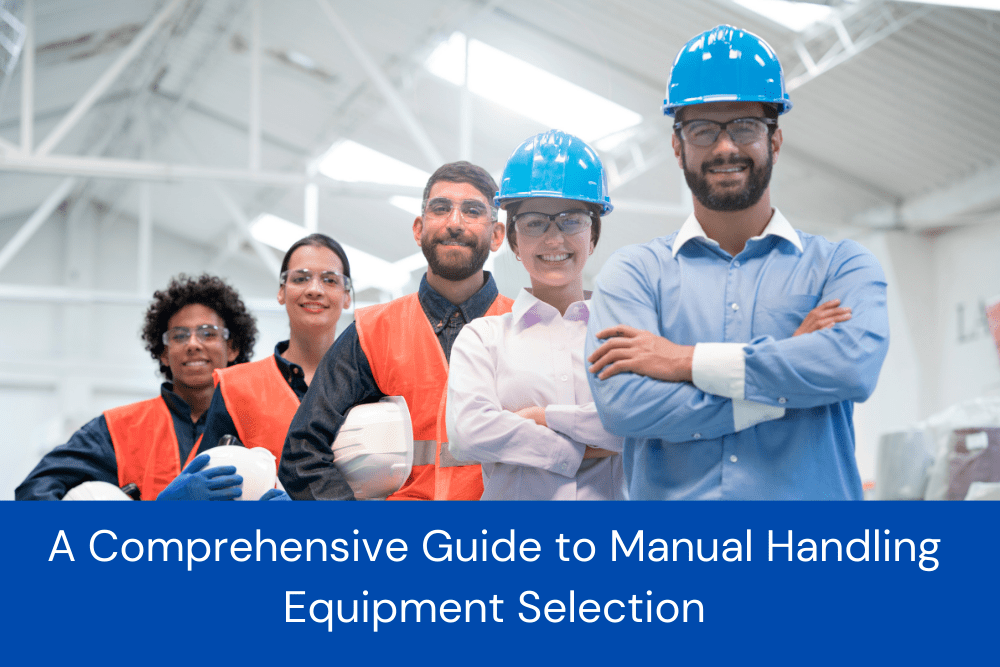Manual handling refers to the process of lifting, carrying, pushing, or pulling objects without the aid of mechanical devices. It is an integral part of various industries, from warehousing and construction to healthcare and retail. Proper manual handling is crucial as it significantly impacts workplace safety and employee well-being. By using the appropriate manual handling equipment, employers can reduce the risk of injuries and enhance efficiency in their operations.
Advantages of Using Manual Handling Equipment
Embracing manual handling equipment offers numerous benefits for both employers and employees. Firstly, it minimizes the physical strain on workers, which can lead to a decrease in workplace injuries and related absences. Secondly, the use of equipment streamlines tasks, leading to improved productivity and smoother operations. Additionally, manual handling equipment can enhance ergonomics, reducing the likelihood of musculoskeletal disorders and chronic health issues in workers. Overall, investing in manual handling equipment demonstrates a commitment to the well-being of the workforce and can result in long-term cost savings for businesses.
Understanding Manual Handling Hazards
A. Common Workplace Injuries Related to Manual Handling
Manual handling injuries remain a significant concern in many industries. Common injuries include strains, sprains, and overexertion due to repetitive lifting or awkward postures. Back injuries are particularly prevalent, affecting the lumbar region and leading to chronic pain and disability. Furthermore, workers may suffer from hernias, fractures, or dislocations during manual handling activities. These injuries not only cause personal suffering but also result in increased workers’ compensation claims and reduced productivity.
B. Factors Contributing to Manual Handling Injuries
Several factors contribute to the risk of manual handling injuries. Poor lifting techniques, such as bending and twisting the back while lifting, are primary culprits. Additionally, carrying heavy or unbalanced loads without proper support can lead to accidents. Repetitive tasks without adequate rest periods can also strain muscles and joints over time. Moreover, environmental factors like slippery floors, cramped spaces, and insufficient lighting exacerbate the risk of injuries during manual handling.
C. Legal and Regulatory Considerations
Compliance with legal and regulatory requirements is essential for ensuring workplace safety. Many countries have specific regulations governing manual handling practices to protect workers’ health and safety. Employers must be aware of these regulations and implement measures to reduce the risk of injuries. Failure to adhere to these standards can result in penalties, fines, and legal liabilities. By following best practices and incorporating appropriate manual handling equipment, employers can demonstrate their commitment to compliance and the well-being of their workforce.
Read more about Compliance with Manual Handling Laws: What You Need to Know here.
Types of Manual Handling Equipment
A. Lifting and Carrying Aids
Lifting and carrying aids encompass a wide range of equipment designed to assist workers in moving objects safely and efficiently. Manual handling tasks that involve heavy or bulky loads can put a strain on employees’ muscles and joints. Lifting aids such as lifting straps and harnesses redistribute the weight of the load, reducing the force required for lifting. Carrying aids like load-carrying vests or backpacks with proper weight distribution help employees carry items more comfortably, preventing undue stress on their bodies.
B. Pushing and Pulling Devices
Pushing and pulling devices play a crucial role in minimizing the risk of injuries during tasks that involve moving heavy objects horizontally. These devices include wheeled dollies, carts, and pallet jacks, which allow workers to push or pull loads with reduced effort. By utilizing such equipment, the physical strain on employees is significantly reduced, and the likelihood of accidents, such as trips and falls, is minimized. Pushing and pulling devices are particularly beneficial in confined spaces where manual carrying might be impractical.
C. Transport and Trolley Equipment
Transport and trolley equipment are invaluable for industries that require the movement of multiple items simultaneously. These equipment types include platform trucks, utility carts, and warehouse trolleys. They are equipped with wheels and handles for easy maneuverability, allowing employees to transport multiple items or large volumes of goods with relative ease. By using transport and trolley equipment, workers can avoid overexertion from carrying heavy loads, streamlining material handling processes and reducing the risk of accidents and injuries.
D. Hoists and Lifts
Hoists and lifts are mechanical devices designed to lift and move heavy loads vertically, often in manufacturing and construction settings. These devices come in various types, such as chain hoists, electric wire rope hoists, and hydraulic lifts. Hoists and lifts not only enhance worker safety by reducing the physical effort required but also enable precise and controlled lifting, lowering, and positioning of heavy objects. These tools are essential for tasks involving objects that are too large or heavy for manual lifting.
E. Ergonomic Tools and Accessories
Ergonomic tools and accessories complement manual handling equipment and aim to improve worker comfort and efficiency. Anti-vibration gloves, for example, reduce hand-arm vibration syndrome when using handheld power tools. Back support belts can provide additional lumbar support during lifting activities. Adjustable height workstations and ergonomic handles on manual handling equipment contribute to better posture and reduced strain. By incorporating ergonomic tools and accessories, employers can further promote the well-being of their workforce and minimize the risk of musculoskeletal injuries.
Assessing Manual Handling Needs
A. Workplace Assessment Techniques
Conducting a comprehensive workplace assessment is the foundation for effective manual handling equipment selection. This involves analyzing the specific tasks and activities carried out within the workplace, identifying potential hazards, and evaluating the physical demands placed on workers during manual handling. Workplace assessment techniques may include direct observations, employee interviews, and the use of assessment tools and questionnaires. By understanding the unique challenges and requirements of the workplace, employers can make informed decisions when choosing appropriate manual handling equipment.
B. Identifying Specific Tasks and Challenges
Identifying the specific manual handling tasks and challenges faced by employees is crucial for tailoring equipment solutions to their needs. Different tasks may require different types of equipment, such as lifting aids for heavy objects or pushing devices for transportation. Moreover, understanding the challenges employees encounter, such as awkward postures or repetitive motions, helps in selecting equipment that mitigates these risks. Employee feedback and involvement in this process are vital, as they can provide valuable insights into the daily demands and obstacles they face during manual handling tasks.
C. Involving Employees in Equipment Selection
Employee engagement in the equipment selection process is a key aspect of ensuring successful implementation. Workers who are directly involved in the selection process are more likely to embrace and effectively use the chosen equipment. Employers can seek input from employees through surveys, focus groups, or individual discussions. By incorporating their preferences and considering their unique experiences, employers can foster a safer and more collaborative work environment. Additionally, involving employees in the decision-making process demonstrates a commitment to their well-being and fosters a sense of ownership over safety initiatives.
Criteria for Equipment Selection
A. Weight Capacity and Load Size
When selecting manual handling equipment, it is essential to consider the weight capacity and load size that the equipment can safely handle. The equipment should be capable of accommodating the heaviest loads typically encountered in the workplace without compromising safety or efficiency. Additionally, the size and dimensions of the equipment should align with the dimensions of the objects being handled, ensuring a secure fit and stable transport.
B. Ergonomic Design and User-Friendliness
The ergonomic design of manual handling equipment significantly impacts user comfort and safety. Equipment with adjustable handles, grips, and height settings can accommodate the diverse needs of workers and promote neutral wrist and body postures. User-friendly features such as intuitive controls and clear labeling make the equipment easier to operate, reducing the risk of errors and accidents. Prioritizing ergonomic design enhances employee satisfaction and minimizes the risk of musculoskeletal disorders arising from prolonged equipment use.
C. Durability and Maintenance Requirements
The durability of manual handling equipment is crucial for long-term reliability and cost-effectiveness. High-quality materials and robust construction ensure that the equipment can withstand the rigors of daily use without premature wear or damage. Additionally, considering the maintenance requirements of the equipment is essential for efficient upkeep and compliance with safety standards. Regular maintenance and inspection can extend the equipment’s lifespan, enhance its performance, and prevent unexpected breakdowns that could disrupt operations.
D. Compatibility with Workplace and Tasks
Manual handling equipment should be compatible with the specific layout and conditions of the workplace. The equipment’s size and maneuverability should align with the available space and accessibility requirements within the facility. Moreover, it should be versatile enough to adapt to different tasks and scenarios, ensuring that a single piece of equipment can fulfill multiple functions efficiently. Assessing the compatibility of equipment with the work environment and tasks helps avoid potential hazards and optimizes workflow efficiency.
Best Practices for Equipment Implementation
A. Proper Training for Equipment Operators
Adequate training for employees operating manual handling equipment is essential to ensure safe and effective use. Training programs should cover equipment operation, safety protocols, and best practices for handling different loads. Operators must learn proper lifting techniques and how to position themselves ergonomically while using the equipment. Regular refresher training sessions can reinforce safe practices and introduce new employees to the correct operating procedures.
Read more about Advanced Training for Manual Handling Safety here.
B. Regular Maintenance and Inspection Procedures
Implementing a proactive maintenance and inspection schedule is critical for maintaining the equipment’s performance and safety standards. Regularly scheduled inspections can identify potential issues before they escalate, minimizing the risk of accidents and equipment failures. Maintenance tasks, such as lubrication, cleaning, and component replacements, should be performed according to manufacturer guidelines. Engaging trained technicians to carry out inspections and maintenance ensures that the equipment remains in optimal condition and complies with safety regulations.
C. Integrating Manual Handling Equipment into Workflows
Seamless integration of manual handling equipment into workplace workflows enhances efficiency and productivity. Employers should strategize how the equipment fits into existing processes, taking into account factors such as task frequency, the flow of materials, and personnel coordination. By streamlining manual handling operations and optimizing the use of equipment, organizations can reduce unnecessary physical exertion and minimize the potential for workplace injuries. Regular evaluations and feedback from employees can help identify areas for improvement and ensure the smooth integration of manual handling equipment into daily operations.
Future Trends in Manual Handling Equipment
A. Technological Advancements
The future of manual handling equipment is marked by exciting technological advancements. Automation and robotics are playing a significant role in revolutionizing manual handling processes. Smart lifting devices equipped with sensors and artificial intelligence can adapt to the weight and dimensions of loads, making lifting and moving objects even more effortless and precise. Autonomous mobile robots are being developed to navigate complex environments, offering a new level of efficiency in material transportation. Furthermore, wearable technologies and exoskeletons are evolving to provide support and enhance the physical capabilities of workers during manual handling tasks, reducing fatigue and the risk of injuries.
B. Improved Safety Features
As safety remains a paramount concern, future manual handling equipment will incorporate enhanced safety features. Manufacturers are investing in research and development to integrate advanced safety mechanisms that detect potential hazards and automatically adjust the equipment’s operation. Anti-collision systems will become more prevalent in pushing and pulling devices, preventing collisions with obstacles or other equipment. Ergonomic improvements will continue to focus on reducing the risk of musculoskeletal injuries, with designs that promote proper posture and minimize strain during operation. Additionally, equipment designers will prioritize user-friendly interfaces and intuitive controls, further reducing the likelihood of human error.

Conclusion
In conclusion, effective manual handling equipment selection is vital for ensuring workplace safety, enhancing productivity, and promoting employee well-being. By understanding the various types of manual handling equipment available, employers can choose the most suitable options to meet their specific needs. Criteria such as weight capacity, ergonomic design, durability, and compatibility with the workplace and tasks play a critical role in the selection process.
- The Ultimate Guide to Manual Handling 2023
- What are the Risks Associated with Manual Handling
- Compliance with Manual Handling Laws: What You Need to Know
- Empower Your Team: Advanced Training for Manual Handling Safety
- How to Prevent Musculoskeletal Injuries in Manual Handling Tasks
- Proven Strategies for Safe Manual Handling: Effective Techniques
- How to Manage Manual Handling Hazards in High-Risk Industries
- Secrets for Better Ergonomics Solutions: Unlock Manual Handling Efficiency
- A Comprehensive Guide to Manual Handling Equipment Selection
Frequently Asked Questions (FAQs)
What is an example of manual handling equipment?
An example of manual handling equipment is a lifting strap, which helps workers move heavy objects by redistributing the load and reducing the strain on their muscles and joints.
Why is manual handling equipment important?
Manual handling equipment is essential because it minimizes physical strain on workers, reduces the risk of injuries, improves efficiency, and promotes workplace safety, resulting in a more productive and healthier workforce.
What is the weight limit for manual handling?
The weight limit for manual handling varies depending on the specific equipment being used. It is crucial to adhere to the manufacturer’s guidelines and ensure that workers do not exceed the designated weight capacity to prevent injuries.
What are the criteria for selection of material handling equipment?
The criteria for selecting material handling equipment include considering weight capacity and load size, ergonomic design for user comfort, durability and maintenance requirements, and compatibility with the workplace and tasks to ensure safe and efficient operations.
What are the 4 types of equipment?
The four types of manual handling equipment are lifting and carrying aids, pushing and pulling devices, transport and trolley equipment, and hoists and lifts, each serving specific purposes in material handling tasks.













